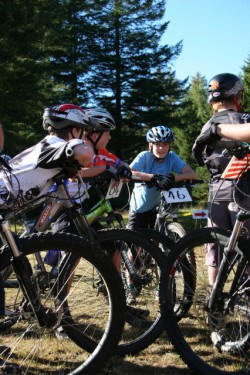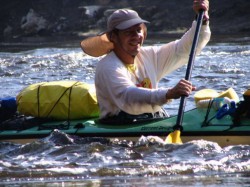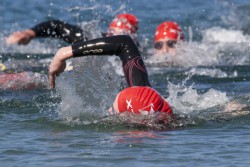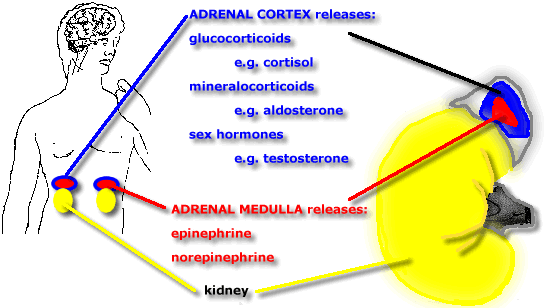|
Fitness Blog Covering Topics Of Interest Tuesday, December 31 2013
One night, you're in a bad neighborhood. A grungy thug comes out of nowhere and starts chasing you down the block. Suddenly, you are able to run faster and longer than you thought you ever could. And this is because your sympathetic nervous system has taken charge, which stimulates your adrenal glands to work harder. But say you have a work assignment that is due the next day, the baby is crying even though you need to get dinner ready for your guests, your other child is screaming at you, and the TV is on full blast in the other room. Your body still interprets this as being under severe stress. The sympathetic nervous system has a hard time shutting off, the adrenal glands are overworking, and problems occur. Unfortunately, modern life often has overstimulation and a lot of pressures and difficulties that keep the sympathetic nervous system in fight-or-flight mode continually. So where exactly are the adrenal glands? The kidneys are located in the lower back region, right around the second lumbar section of the spine just under your waistline, depending on the person. The adrenal glands are situated right above the kidneys. The body is a whole universe with an extensive communication network. The body's nervous system breaks down into two parts: the central nervous system and the peripheral nervous system. The autonomic nervous system is part of the peripheral nervous system. The autonomic nervous system is responsible for involuntary movements and actions. It controls heartbeats, breathing, digesting, sweating, crying, etc. It is divided into the sympathetic and the parasympathetic nervous systems. The sympathetic nervous system controls the fight-or-flight response. This means how your body responds to emergency and stressful situations. When the sympathetic nervous system is switched on your parasympathetic nervous system is switched off so that your body can cope with the emergencies more efficiently. When the sympathetic nervous system is on your heart rate increases, you sweat, your pupils dilate, and your body shuts down your digestion system so that it can focus on dealing with the emergency. The parasympathetic nervous system kicks in when the sympathetic nervous system switches off. Your heart rate returns to normal, your digestion system starts back up, and body functions return to normal. Although the nervous system's main communicators as neurons, the endocrine system's main communicators are chemical messengers known as hormones. Hormones are carried in the bloodstream to specific areas of the body, including organs and body tissues. Some of the most important endocrine glands include the pineal gland, the hypothalamus, the pituitary gland, the thyroid, the ovaries, and the testes. When the sympathetic nervous system has been in flight-or-fight too long, it affects the hormones of the adrenal system. Too little or too much of the hormones can lead to adrenal fatigue and because of the way this fatigue impacts the body, it can lead to illness. This process of adrenal fatigue does not happen all at once. Instead, it is a gradual breakdown in the body. The Three Phases of Stress In 1956, endocrinologist Dr. Hans Selye developed a key concept in the study of stress and its effects on the body, which he termed, the general adaptation syndrome. In the general adaptation syndrome, the body passes through three phases in the way it copes with stress:
1. Alarm Phase This can cause those raised knotted shoulders, tight upper back and neck, chills along the spine, clammy hands, cold feet, increased heart rate, a tight locked pelvis, and tight leg muscles. A good example of this is in someone who has just had a car accident - a hugely stressful event. Just as their body responds to stress by causing the upper back and legs to tighten, the muscles are jerked quickly, causing injury that can take time to heal. On the other hand, the body does this to stay alive, so that the heart can keep pumping blood even under poor circumstances, and so the person won't feel pain as quickly - that's the beauty of the sympathetic nervous system's response. In the alarm phase, stress is relatively short lived and the return back to homeostasis is with ease. A list of what happens during a fight-or-flight response:
Symptoms: Shortness of breath, palpitations, emotional instability, headache, back pain, decrease in frequency and quantity of urination, insomnia, lack of appetite, dizziness, nausea, eye pain, cold hands and feet, tight neck and upper back muscles. Options on how to treat this stage:
2. Resistance Phase In the resistance phase, constantly reacting to stress leaves the body depleted, leading to a general decrease in overall resistance to illness, inflammation, and pain. Stress is wearing the body out even though the body is still resisting it. There is constant energy being sent by the adrenals and sympathetic nervous system to only the most important organs for a flight-or-fight circumstance. For example, since digestion is a parasympathetic function, undigested food begins to enter the colon, causing gas and bloating, and as the body can't pull the nutrients out of food as efficiently, there are less number of important nutrients to keep the body healthy and pain free. Secretion of the adrenal hormones is initially still high, but slows down as they begin to wear out. The sympathetic nervous system weakness leads to sympathetic deficiency. The parasympathetic nervous system begins to become more dominant as it attempts to compensate. The parasympathetic nervous system will switch on and take over, but not because the sympathetic nervous system has switched off, but because it's so exhausted that the parasympathetic nervous system has to pick up the slack so the body can function. What occurs is a constriction of blood vessels such as capillaries and arteries in the brain, excitement of the digestive system, and adrenal gland deficiency along with a whole host of problems listed below. What happens during the Resistance Phase? What kind of patient has moved from the Alarm Phase to the Resistance Phase?
Symptoms:
Options on how to treat this stage: All the recommendations from Stage 1 will help, but here are a few more for the more severe stage 2. All of these should be checked out with a doctor first as you may be having more severe symptoms stemming from stress (for example, high blood pressure):
Stage 3: Exhaustion Stage Possible Consequences of Exhaustion Phase:
Sources - Bodymind Energetics Towards a Dynamic Model of Health. By Mark Seem, Ph.D. Saturday, October 05 2013
This quick and simple salad is a delicious solution to the age-old question, “What’s for dinner?” It’s filled with wholesome ingredients, protein and fiber to enhance your hard earned fitness results. Servings: 6 For the Salad
For the Dressing
Instructions
Nutritional Analysis: One serving equals: 218 calories, 12g fat, 189mg sodium, 5g carbohydrate, 4g fiber, and 22g protein Wednesday, March 13 2013
The prostate gland depends on testosterone for growth and development. Prostate cells, both noncancer and cancer, do too. This is why prostate cancer is sometimes referred to as a hormone-dependent cancer. Higher levels of circulating testosterone lead to higher concentrations in the prostate, and this appears to increase the risk of clinically significant prostate cancer. However, higher testosterone levels are not consistently found in prostate cancer patients, so there is more to the relationship. A possible protective role of exercise has been proposed based on its ability to lower testosterone levels and to boost the immune system. Exercise causes a temporary reduction in testosterone, so regular exercise can reduce long-term exposure to testosterone. And chronic exercise has been shown to increase the number and activity of natural killer cells, which are part of the immune system that attack cancer cells. Based on these effects, it seems that exercise should be beneficial, but the evidence concerning the impact of exercise on prostate cancer risk is inconclusive. In a review of 17 epidemiological studies of varying quality, 9 showed a beneficial effect, 5 no effect, and the other 3 actually showed an increased risk related to exercise or physical activity. None of the studies, however, provided conclusive proof, but taken together, they seem to support a weak beneficial effect of regular exercise on prostate cancer risk. The challenge is proving that men who exercise regularly develop less prostate cancer when all other factors are the same. This requires a prospective long-term randomized study, and this probably will never be done. The best long-term prospective studies that looked at habitual physical activity in adulthood are encouraging, however. A study of nearly 18,000 alumni of Harvard University showed that those who maintained a high level of physical activity were about half as likely to develop prostate cancer after the age of 70 as those who were least active. Another prospective study evaluated the level of physical fitness, as well as physical activity, on the risk of prostate cancer. Higher fitness levels were associated with lower risk in men under 60, but not in older men. And men who expended more than 1,000 kcal per week in exercise had lower risk than those who did not get this much exercise. The best long-term study of men's health is the Health Professionals Follow-up Study. It began in 1986 and has followed over 47,000 men in various health occupations since then. Data was collected in the beginning, and periodically through the study, on many factors including physical activity. The only positive result through 1994 was that at least 3 hours per week of vigorous physical activity was associated with a reduced risk of metastatic prostate cancer. But no relationship was observed between physical activity and the incidence of total or advanced prostate cancer. The same study, however, found an inverse relation between physical activity and BPH, more activity meant a lower likelihood of urinary symptoms or surgery for BPH. Walking 2–3 hours per week was enough to lower the risk of BPH. The bottom line is that questions remain about the relation between exercise and prostate cancer, but there is no question that regular exercise is good for general health. So, it is wise to get some moderate exercise on most days of the week, and you may be protecting yourself from prostate problems, too. Sunday, February 10 2013
Preparation Time: 10 minutes Cooking Time: 3 minutes Serves: 4 This recipe is to make really healthy protein pancakes. The ingredients provided will make about 4 pancakes but you can make them how big or small you want. Ingredients
Steps
Wednesday, January 23 2013
Remember when a total cholesterol reading of under 200 was the standard for judging cardiovascular health? Today, of course, we know that it's the components of cholesterol (LDL, HDL, the size of those cholesterol particles, and triglycerides) that are much more predictive of heart health. Well, our understanding of total weight and its effects upon your heart has evolved in similar fashion. It's not your total weight but the characteristics of that weight—how much is fat and where it's deposited—that matter most.
Surprised? Thank the scientists at the Mayo Clinic, who are behind this recent discovery. After comparing various health markers with the weights and body mass index numbers of thousands of adults, they found that more than half of those with normal weights and BMIs actually had "high body-fat percentages as well as heart and metabolic disturbances." In other words, they had the same risks of coronary disease, diabetes, and other chronic illness as people who weighed much more. This research, and its sobering implications for millions of Americans, led to the establishment of a new condition called normal weight obesity (NWO). This is more than just the latest fat phobia. It's worth paying attention to because the accumulation of fat in the body, especially in the belly and around internal organs, causes low-level inflammation that gradually damages tissue and blood vessels. (Think of it as metabolic rust.) So even though your weight or BMI may be within acceptable limits for your height and age, don't be lulled into a false sense of security. Do your own analysis, starting with these steps: 1. Stop being preoccupied with pounds. As with total cholesterol, total weight is just one general assessment of your health. Yes, people who are trying to lose weight are more likely to succeed if they weigh themselves often. But seeing numbers that are within a healthy BMI range may actually disguise your heart disease risk. Keep them in perspective. 2. Measure your body fat. For a quick estimate of this key factor, wrap a cloth measuring tape around your naked waist just above your belly button. If your weight is fairly normal but the number you see above your navel is 35 inches or more (40+ inches for men), you may have NWO. For a more exact reading, ask your doctor (or health club) to measure your body fat. This can be done using a variety of noninvasive methods. If it's higher than 30 percent (20 percent for men), you likely have NWO. 3. Get a blood test. Ask your doctor to order a thorough blood analysis at your next physical. Warning signs of NWO include low HDL (total cholesterol and LDL may be normal), along with elevated triglycerides, blood sugar, and blood pressure. 4. Target belly fat. If you're diagnosed with NWO, take aim at visceral fat. Despite how entrenched it may seem, you can lose it. The keys are: Avoid the white stuff (white bread, rice, pasta, and other refined carbohydrates). Add monounsaturated fats, which target belly fat, to your diet. And do interval exercises to burn more fat and strength-training to build lean body mass. 5. Keep tracking fat. Just as you hop on the scale to keep tabs on your weight, do the same with your body fat. Have it measured periodically at your doctor's office or health club. Or just observe the notches where your belt buckles. Conversely, if you're considered overweight by current standards, there may be some good news here. If your body-fat percentage is lower than 30 percent (20 percent for men) and your blood chemistry is normal, then you are among the "fat and fit." (Many athletes are in this category.) Continue to eat smart and exercise, but accept your body for what it is and know you're not unhealthy because of it. Feeling fat and feeling healthy are no longer mutually exclusive. More Heart-Healthy AdviceStaying hydrated is one simple way to keep blood pressure in the safe zone.Wednesday, December 12 2012
This Indonesian dish packs a massive flavour punch and is quick and easy to make. Ingredients
Steps
Other Dietary Information
Sunday, June 10 2012
 © Betty Shepherd Summer is such a beautiful time of the year. Happy days with stunning sunrises, long, warm evenings and relaxing afternoons freshened up with lemonade and watermelon. Even on hot days, it is not difficult to find great exercises to keep your fitness level up. Summer is also special because you can finally do the workouts you might have been missing during the colder months of the year. You even can take advantage of the training sessions you would not necessarily do during the ideal training period for other sports in winter. You can add cross-training, as well. That means you can work out in other sports or add exercises that support what you normally focus on. It gives you an opportunity to prepare yourself for your upcoming autumn events or improve your fitness and skills for your favorite winter sports. Cross-training can give you a wide variety of workout choices which can enable you to reach your goals. In the summer, you have a wonderful opportunity to take advantage of the outdoors and experience beautiful connections to nature—the oceans, lakes, rivers, beaches, mountains, and shady woods and forests. Before we go on, however, I would advise getting a physical before you start your summertime fitness, making sure you are fit enough to work out in those warm conditions and are able to stay ahead of the game. It is a time that is good for more than just goal setting. You also can talk about your fitness ideas and workout possibilities for the upcoming months and decide if they are realistic for you. Your Favorite Summer WorkoutsOf course, in summer—as well as year-round—do activities you enjoy. They might include your favorite ball game, long hikes, water sports, or anything that is giving you excitement and happiness while exercising. Maybe you have some “wishes” you can turn into goals—like improving your fitness, learning to surf, running your first 5K, hiking a mountain, or biking some new trails by the end of the warmest time of the year. When you follow a path of realistic and achievable short-term goals, it can be much easier to stay motivated and make it fun to reach your goal.  © Betty Shepherd It always is a good idea to include your favorite workouts first, then, integrate new opportunities as the summer progresses. By the end of the warmest months, you will have explored and tried different exercises—alternatives you may have been curious about, perhaps, and had thought could be fun for you. Ball games, swimming, water sports, mountain biking, running, hiking, camping, for example, all are great exercises to try during the summer, especially if you had never done so before or if it had been a long time since you did them. And if you are ready to take on multiple challenges, nothing might be better than combining a number of activities. My favorite summer workouts are those easy and relaxing evening runs, when the sun starts to set and the air is getting fresher, when I can play with those long shadows in the forest. I often combine them with a swim, diving into a lake after my run. Sometimes I jog a few miles to a beach by a lake and cool-off by swimming for some distance, depending on how I feel after my run. I used to do this often as a kid and later during my track season. I have enjoyed it ever since. As the previous comment illustrates, summer workouts are a great way of rekindling happy childhood memories: those long days of carefree summer vacations from school, playing baseball, basketball, or soccer, or maybe completing a track session in the stadium. Perhaps you have a loving memory of the smell of freshly cut grass. That wonderfully distinctive aroma always reminds me of the newly-mown infield at the local track when I was a kid. During the warmest time of the year, it is best to wait for temperatures to have fallen in the early morning or the late evening. Any kind of ball game—basketball, baseball, soccer, or tennis—is fun to play in the cooler evenings. With dusk still far away, you can arrange to get together with your friends after work and add informal versions of these games to your other activities. This can be fun and often makes it easier to stay fit. When I was growing up and started running, we played lots of ball games as warm-ups for our training sessions. A game of team handball or volleyball was just right for us kids. Coming from Germany, soccer always was the favorite. Maybe you can join a group of friends to play a game? You will soon find the countless sprints to get the ball or trying to keep it will definitely give you good cardiovascular exercise. Huffing and puffing, I sometimes had to stop running to catch my breath. For many of us, nothing is nicer than taking part in summer water sports. You can enjoy the whole day at a lake or the ocean with activities such as paddle boarding, kayaking, surfing, snorkeling, or playing different water ball games with your friends. These all are sports that can provide fun activities for you and your entire family. If you don’t have the luxury of a few free days, try a nice swim before or after work, or, if time permits, during your lunch break. Swimming is not only a great cardiovascular workout, and refreshing during the summer months, it also can help you recover from more strenuous training like biking or running. And, at the same time, it will improve deeper breathing.  Dave enjoys kayaking across the state of Florida. © Dave Bracknell A former client of mine started with a few sprint triathlons in the summer and quickly moved up to the Olympic distance in winter. He later discovered that kayaking would be fun for him, too. I got an email message from him with breathtaking photos of the ocean and his kayak resting on a beach. He wrote that he just kayaked across the state of Florida in a charity event. I can imagine that he had a fun pool party afterwards! It is a great idea to start a party with your family and friends in late afternoon, playing ball and enjoying swim games, and later taking in the sunset while having a super-tasty barbecue. Could an interesting hike become one of your favorite workouts? Even a leisurely “glow worm and fire flies” hike on a cool summer night might be something you would enjoy. It can be such a fun activity for the whole family. And if you choose a long day hike, you might want to top it off by camping out overnight under the stars. Change the Venue, Adjust Your Goals, and Explore Cross-TrainingSure, you want to avoid the hottest part of the day—so go inside! Join a gym for the warmest months, and instead of running or biking outside, try the treadmill or the stationary bike or one of the many other aerobic exercise machines available at most gyms. You always can exercise outside during the cooler temperatures around sunrise and sunset. The nice thing about summer events is that most of them take place in the morning or evening hours. Nothing is better than completing your workout or event and meeting friends for a late breakfast afterwards. “It’s just a piece of pancake!” Adjust your fitness goals for the warmest time of the year. As always, it is best to set realistic, achievable, short-term goals. I recommend focusing on a few shorter workouts with higher intensity and playful variations in speed. Perhaps your goal might be to become faster in your sport during the summer. Then in autumn, you can add some endurance and focus on longer events again. Once you accomplish your summer goals, you can use your improved fitness to achieve great results in your events later in the year.  © Betty Shepherd Here are some ideas. If you are a triathlete, you might want to improve one of your disciplines to be better prepared for competition in the fall. To work on your swimming might be a good idea. Or you might change from running to more biking, and in the colder months add longer running workouts again. There are great duathlon competitions in the summer. To work on improving your speed, you may decide to prepare for a sprint triathlon or a sprint duathlon, instead of the longer versions. Many runners may just have finished a spring marathon. The warm summer months are ideal to prepare for a 5K, and in late August one could prepare for a 10K. Then, in September, you can get ready for a half marathon. All the training and goal setting can be done with the ultimate aim of a faster marathon. Or simply enjoy the shorter distances as your main event all summer. That is good, too! You also can switch from one sport to another. Think “off season training.” For runners, bike and swim instead of doing high mileage running. Some bikers go from the road into the forest and mountain bike, it is a great way to improve your skills. Enjoy water sports like kayaking or paddle boarding. Compete in team swimming events, relays are always great fun. A good goal could be to work on other elements of fitness, like strength or technique training, especially if these are areas in which you already want to improve. To do this, you may want to include these new elements in your routine during the summer so you are better prepared for your upcoming events later in the year. I love these elements of cross-training. They can give you a chance to try out a variety of workouts—not doing the same activity every day. And they can be done indoors during the warmest hours of the day. Think about it as something you can look forward to complement your training. Deep-water running, core strengthening, light weights, stretching and yoga… they all can be added to your summertime fitness routine. In this manner, you can condition your body for your fall events—to be a better runner, biker, or golfer—and for your winter sports to be a stronger skier, snowboarder, or skater. Be prepared to adjust your workouts according to the weather conditions on any given day. It can be hot, humid or rainy, and setting a new and easier goal will help you achieve them. Maybe you, too, would love to combine some of your runs with a cooling swim afterwards. And finally, a general suggestion for your summer workouts: start them slowly, increasing your workload in gentle increments. The weather conditions can be challenging and even deceptive. By starting your workouts carefully, keeping your strength in reserve, you will be able to keep your body temperature and your pulse lower. And you will not get so fatigued. In many climates, temperatures can change dramatically over the course of the day, so always be aware of the conditions in which you do your activities and training. Of course, during summer months, adequate hydration should always be on your mind. Fitness Programs and Sport Events You Can JoinCheck out recreational leagues and programs for adults and kids in your area. Your town, local fitness club, and local businesses might offer programs for many sports and events, and maybe you would like to join one of them. This way you also might meet new friends and enjoy staying fit together. It might even not feel like working out hard at all. There are many events over the summer that may be of interest to you. Some of them are charity rides or runs where you also can get the satisfaction of helping your community or a charity that touches your heart like SOS Outreach with which Take The Magic Step is a partner. In “Summertime Fitness: Part II,” I will explore proper hydration and offer a few thoughts on summer nutrition. Until then, I hope you can enjoy your fun and cool summertime fitness!
|
 |





